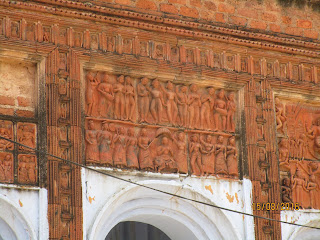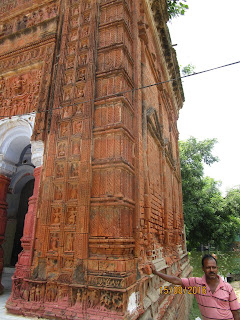When
we talk about tangible heritage of our country we tend to discuss the
engineering marvels of those structures, but what lies beneath such discussion
is the story of those who made that possible. In Bengal, Terracotta artisans
created many marvelous works which amaze us even today. The word ‘Terracotta’
may remind you of the temples of Bishnupur but in Birbhum we get a different
flavor of it.
Birbhum is the treasure box of Bengal terracotta. Terracotta temples are scattered through the landscape of Hetampur, Surul, Ilambazar, Ghurisa etc. These terracotta temples not only represent the prosperity of Zamindars but there are rural customs and folk culture depicted on the walls of those temples. Surely Folk arts and handicrafts occupied a conspicuous position in our rural life in bygone days. The moribund days of flourishing terracotta craftsmanship are no more. Terracotta craft formed a prominent part of social and cultural life of medieval and Early modern Bengal. Apart from the connoisseur Landlords of Bengal, Vaishnavite movement had much to influence this art.
Indeed prosperity gives enough room for the emergence of such art. The temples of Bishnupur and Birbhum are the expression of such prosperity. It is very evident from the way they were built. In Bishnupur political achievement of Malla Kings was merged with Vaishnavite culture while Birbhum saw economic prosperity along with culture of education in traditional philosophy and script.
Most of the temples of Birbhum appeared in medieval period, but such per iodization is not beyond debate. But what is beyond doubt is that these are old enough and probably the oldest one lives in Ghurisha, a village of Ilambazar police station. It is situated 7 K.M. west of Ilambazar. It has ruins of old time brick build houses and several hundreds of tanks speaking of its past glory. Ghurisha was one of the renowned places of learning philosophy and scripts in Birbhum.
Thus the Pundits (learned person) of Ghurisha became the forerunners of temple inauguration. Raghuttam Acharya, one of the leading pundits of Ghurisha from 17th century, inaugurated Raghunathji temple which is probably the oldest terracotta temple in this region. The Raghunathji temple was built near about A.D. 1633 and this is a Charchala (char=Four) temple. Though we find the name of the inaugurator but one will fail to find any of the names of artisans. There are different figures depicted on the wall. Some of them bear indication of female cults from hindu myth; even a Chhinnomasta figurine (other name of Kali) can be found which is rare with respect to other figures from other temples. It is not feasible to recognize all the figures as many of them are perishing. Even from different parts terracotta plaques have disappeared. It is said that a gold image of Rama was removed from the temple to protect it from Maratha raiders (bargies) between 1742 and 1751.
The
area was thoroughly observed by Benoy Ghosh, an eminent scholar, many years ago
and what he found was so alarming. Rammoy Panchotirtha, A descendant of
Raghuttam Acharya, who built that Raghunathji Temple explode his grief for the
abandonment of those structures. What that man showed to our culture was his
ultimate wish to protect our moribund past. He took the decaying stone
inscription, on which the date of foundation was erected, and put it on the
wall of his residence. He did it for the survival of a culture.
There
is another temple in the vicinity of Raghunathji Temple which is a Navaratna
Mandir. It was founded by Kshetramohan (or Nath) Dutta who was a Gandha-banik
by caste. He made lot money after dealing with the Europian Marchants who lived
in Illambazar. It shows us the social mobility in Bengal of that period. Spectacular
work of terracotta can be seen here. Though some protions of this temple seems
different from other parts but when we get to see figures like Tirpura-Vairabi,
Tara, Saraswati and Ganesha on the lap of Durga we are startled with the
representation.
When
we visited this temple some local folk came up to us told that they did many
things to preserve this temple but they were curious to talk with us. They
might have thought that what they were unable to do would be feasible for us.
There
is many more Raghunathji Temple throughout Bengal. The days of Raghuttam
Acharya are gone but what exists is the shadow of a culture. Thus it is our
responsibility to prolong that shadow in the memory of those who evolved that
culture and those who successfully built it. What you say ?
References
1. Poschimbonger
Sanskriti (part I), Benoy Ghosh, Prakash Bhaban, Kolkata ,2014.
2. Social
Mobility in Bengal, Hiteshranjan Sanyal, Papyrus, 1981.
3. Temple
Terracottas of Birbhum, Mukul Dey.
4. West
Bengal District Gazetteers: Birbhum by L.S.S. O’Malley. And by Durgadas
Majumder.(1973).
5. Temple
Terracottas of Bengal/ Mukul Dey Archives. www.chitralekha.org/articles/mukul-dey/temple-terrocotta.
Research & Picture Courtesy - Sritam Mukherjee.
Research & Picture Courtesy - Sritam Mukherjee.





















No comments:
Post a Comment